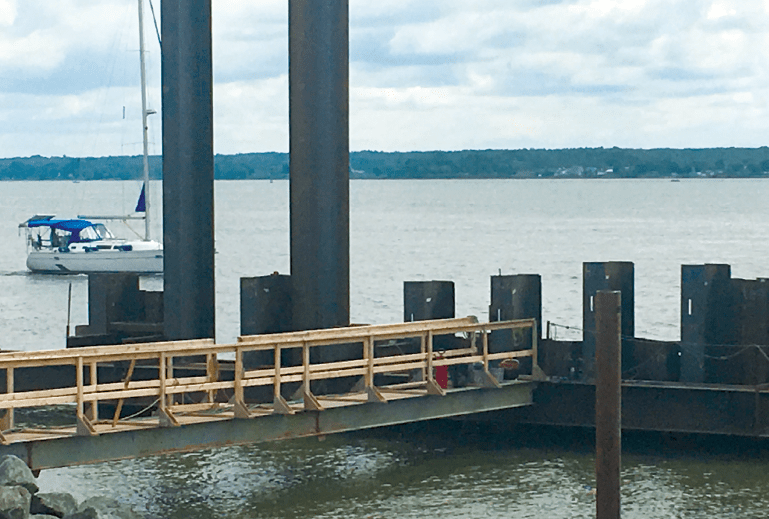
Nucor Skyline assisted in bringing the almost 200-year-old port into the 21st century
By Janet Himstead, Nucor Skyline
The Port of Trois-Rivières is on the St-Lawrence River, between Québec City and Montréal, at the confluence of the St-Maurice River. A large multi-modal facility, it combines sea, rail and road, and serves both domestic and international markets.
One of the largest ports in Québec and Eastern Canada, the port handles approximately 55,000 trucks, 11,000 freight cars and 240 ships per year. The products that flow through the port are varied and include general cargo, dry and liquid bulks.
The Port of Trois-Rivières was established in 1824, with the first dock and warehouse built by the owner of the Forges du Saint-Maurice, Mathew Bell. John Molson, a powerful ship owner of the day, immediately followed suit and built three docks in 1825, and acquired several more in 1840. As these were private facilities, the municipal administration determined that a public dock was needed for the ferries connecting the city to the village of Sainte-Angèle-de-Laval, on the south shore of the Saint Lawrence River. The year was 1858, and this was the first public initiative for the port. Since then, the port has gone through many changes and has been overseen by several different agencies, including the Council of National Ports, a federal agency that manages many large Canadian ports.
The Trois-Rivières Port Authority, which has managed the port since 1999, has undertaken a large project to overhaul some of the outdated wharfs and facilities at the port. One of the major construction projects extends Pier 10. This extension replaces the aging and obsolete Pier 9, which was built in the 1930s. The extension of Pier 10, with a berthing length of 133 metres, increases the outdoor storage space at the pier from 3,000 square metres to 12,000 m2.
These improvements enable the port to better support the development of the regions it serves. Port of Trois-Rivières is an important economic development tool for several regions of Québec and supports many regional companies in the shipping of their products and in the supply of their raw materials.
In order to accelerate the process, the Port decided to tender the project seeking design-build solutions. Nucor Skyline was able to offer design assistance and proposed various options to interested bidders.
Hamel Construction of Québec City was awarded the contract for the multimillion-dollar project.
Conditions at the site, including soft soils on the bottom of the Saint Lawrence River, favoured the use of a king pile wall, anchored with tie rods to a buried sheet pile wall. The HZ-M king pile wall was the most cost-effective system for this pier extension. The design allowed water depths of 12 m and a final retained height of 17 m from the top of the wall to the river bed.
Combined wall systems, utilizing king piles and pairs of intermediary piles, are often used in marine applications where they provide increased capacity compared to regular sheet pile walls. The Nucor Skyline HZ-M system is fully interlocking and is composed of heavy king H-piles with sheet pile connectors attached to the flanges to permit the threading of intermediate sheet piles. The intermediary sheet piles transfer the soil and water pressures to the king piles, which carry most of the load. The king piles are the primary element in combined wall systems and are usually 25-60 per cent longer than the intermediary piles. This allows for increased axial capacity of the system.
To optimize the final design solution, Nucor Skyline suggested a higher grade – S430GP steel (430 MPa) – for this project. Nucor Skyline also provided cold formed sheet piling for the anchor wall and a tie rod system composed of threaded bars with couplers to facilitate installed lengths of 35 m. Each of the 80 king piles were tied above water level with an articulated system. The bars were spaced at 1.9 m and connected directly to the king piles. With one tie rod per beam there was no need for a waler system on the main wall, only the anchor wall.
The construction of this project began in early June 2017, with the contractor preparing the site by demolishing the aging Pier 9 and excavating as needed. This phase was immediately followed by the installation of the stone embankment along the river. In mid-July 2017, driving began for the combined wall system, with 11 to 15 metric ton king piles driven 18 m deep by a vibratory hammer. The king piles ranged in length from 28.65 m to 33 m. The intermediary sheet piles, ranging from 18 m to 22 m, were then driven eight metres through the soft soils of the riverbed. Ocean vessel delivery ensured the supply of long lengths in one piece directly to the Port of Trois-Rivières.
The new wharf section is now in full operation and provides year-round service via the seaway.
For more information, please visit: nucorskyline.com.
-
From Historic Foundations to Modern Marvels
April 18, 2024 -
Canadian Construction Trends for 2024
April 16, 2024 -
Substance Use in the Trades
April 12, 2024 -
Putting Technology to Work in Your Business
April 12, 2024 -
A Matter of Life or Death
April 12, 2024
